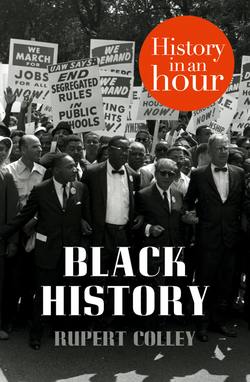Читать книгу Black History: History in an Hour - Rupert Colley - Страница 6
ОглавлениеSlavery:
The ‘Peculiar Institution’
Seventeenth-century British North America needed labour. Tobacco, rice and indigo were potentially profitable industries but the manufacturers lacked the manpower to work the vast fields efficiently. The transatlantic slave trade, already delivering slaves from West Africa to the European colonies in the West Indies, began providing slaves to the ‘New World’, the first arriving in Jamestown, Virginia in 1619. From Senegal in the northern reaches of West Africa to Angola in the south, African rulers, such as the Yoruba kingdom of Oyo on the Guinea coast and the leaders of Dahomey (modern-day Benin), built successful kingdoms by delivering hoards of their fellow Africans to the European and North American traders.
Contemporary poster illustrating the layout of a slave ship
The traders sailed for Africa and bartered with the local African slave merchants, exchanging textiles, armoury, luxuries and alcohol for slaves. The slaves were local criminals, misfits, debtors, or increasingly, those randomly kidnapped from neighbouring tribes.
The journey across the Atlantic lasted several weeks and was a desperate passage. Frightened Africans, torn from home and family, were crammed into the bowels of a ship where overcrowding, lack of ventilation, insufficient nutrition, minimal toilet facilities and constant seasickness made for appalling conditions.
For the white merchants, very aware of how numerically outnumbered they were, mutiny remained a constant fear, necessitating brutal means to keep their cargo in check. Manacled and beaten, the slaves cowered. But it was disease, particularly dysentery, which posed the greatest threat. Once fully at sea, the slaves were allowed time on deck to help minimize the threat. Those showing even the smallest symptom of contamination were immediately thrown overboard. Commercially it was vital that as many slaves should arrive intact as possible.
Once at their destination, the slave faced an uncertain future. Those fortunate to be sold to a ‘good master’ found themselves in smallholdings in the Southern colonies of British North America, where lighter work combined with better food and provisions made this the least feared destination. The not so fortunate were dispatched to the Caribbean and on to the huge sugar plantations. Many failed to acclimatize to the conditions and the work, and up to 10 per cent died within their first year. Those who did survive this initial period were considered ‘seasoned’, in other words to have adapted to their new conditions and to have successfully made the transition from African to slave.
Sugar was the staple commodity of the Caribbean but the intensity of production impoverished the soil and the focus of British colonial production shifted to the American colonies.
In 1775, the thirteen North American colonies broke away from British rule and, following the American Revolution, became the United States of America. Blacks had served on the American side against the British, fighting alongside white soldiers at several battles. Crispus Attucks, a former slave, had died a martyr’s death in 1770, shot by the British whilst fighting in Boston for American independence.
But the recruitment of black slaves to the American cause was abruptly stopped when George Washington took command in 1775. The British, however, promised every slave their freedom if they came over to the British – or Loyalist – side. When America won the war and demanded the return of the ‘Black Loyalists’, the British refused and helped some 4,000 escape abroad, many to Nova Scotia or to London.
Thomas Jefferson, in the draft Declaration of Independence, wanted to speak out against slavery, the ‘peculiar institution’ as it was called, but it would have isolated the Southern states and weakened the Union from the outset. Unity was more important than the freedom of the slaves and the anti-slavery clause was quietly dropped.
Fourteen years after independence, the United States conducted its first national census and found that 757,363, or 19 per cent of the total population, were black. Of these, 697,897, or 92 per cent, were slaves, and 94 per cent of those slaves lived in the Southern states.
A whipped slave, 1863 Illustration from Harper’s Weekly
The slave was considered property. They had no civil rights, no rights in the judicial system, no access to education, no say in where or how they lived or worked; they were at the total mercy of their owner. The slave had no more rights than a mule. If an owner whipped or raped a slave, the slave had no recourse to complaint, nor any route to justice.
Slavery existed in all thirteen Southern states, but amongst the Northern states a strong anti-slavery voice arose, led, in the main, by the Quakers, whose opposition was based on moral and religious grounds. In 1780, Pennsylvania, with its strong Quaker influence, became the first state to abolish slavery within its borders, although Vermont, at the time a territory, had abolished slavery three years previously. Massachusetts, North Hampshire, Connecticut, Rhode Island, New York and New Jersey followed suit. By 1804, slavery had been banned in every Northern state. By 1810, there were over 185,000 free African-Americans in the US, virtually all in the North.
The country, barely a quarter of a century old, was firmly split between the North and the South.
